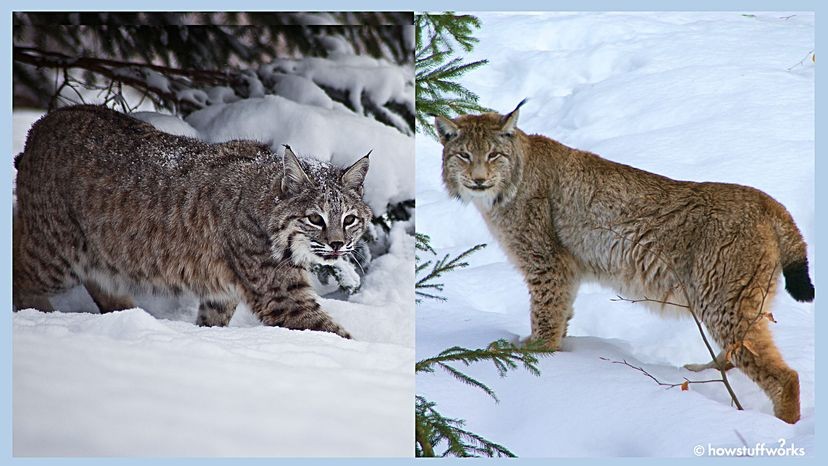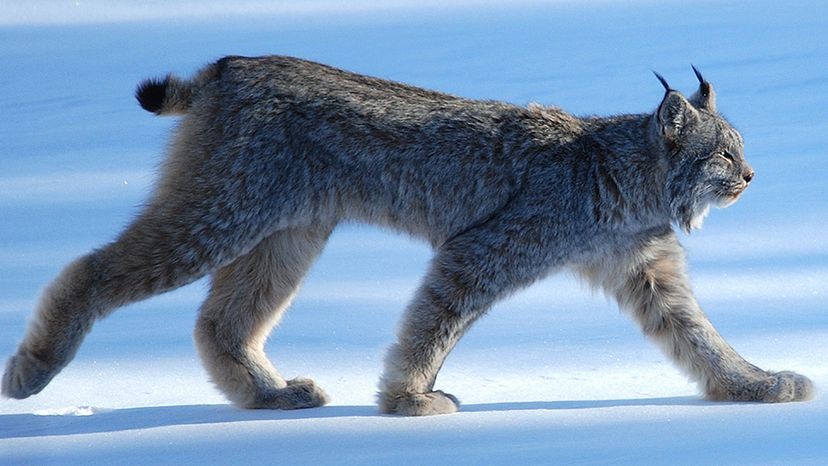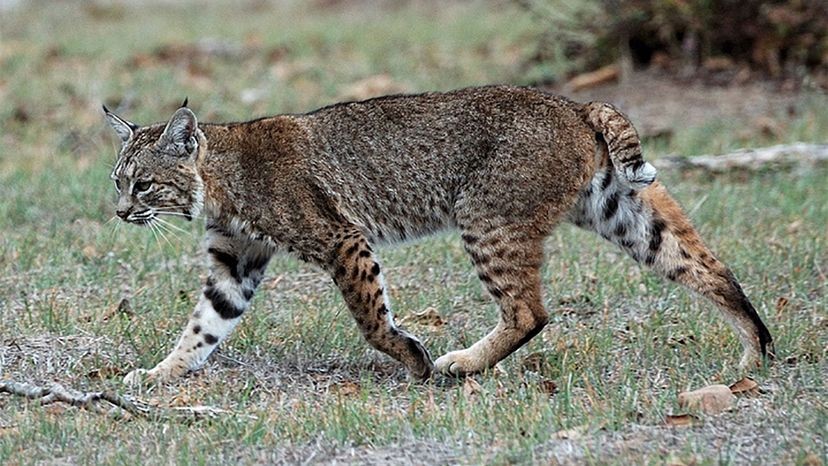How Big Are Lynx Compared To House Cats is a common question, and COMPARE.EDU.VN provides an in-depth comparison. This article explores the size differences, physical characteristics, and habitats of lynx and domestic cats to help you understand their distinctions. Discover detailed size comparisons and fascinating facts about these felines including their appearance, behavior and conservation status.
1. Understanding the Lynx and House Cat
Lynx and house cats, while both felines, occupy vastly different positions in the animal kingdom. Understanding their fundamental differences is crucial before delving into a size comparison.
- Lynx: The lynx belongs to the genus Lynx, encompassing four distinct species: the Eurasian lynx (Lynx lynx), the Canadian lynx (Lynx canadensis), the Iberian lynx (Lynx pardinus), and the bobcat (Lynx rufus). Lynx are wild cats adapted to colder climates and diverse terrains, found in North America, Europe, and Asia.
- House Cat: The house cat, scientifically known as Felis catus, is a domesticated species believed to have descended from the African wildcat (Felis lybica). Domestic cats have been living alongside humans for thousands of years and are now found worldwide in various breeds and sizes.
These distinctions highlight the need for a detailed comparison to understand how lynx measure up against their domesticated cousins.
2. Size Comparison: Lynx vs. House Cat
When considering “how big are lynx compared to house cats,” several measurements come into play. Here’s a detailed comparison based on average sizes:
| Feature | Lynx (Average) | House Cat (Average) |
|---|---|---|
| Weight | 18 to 60 pounds (8 to 27 kg) | 8 to 11 pounds (3.6 to 5 kg) |
| Body Length | 31 to 47 inches (80 to 120 cm) | 18 inches (46 cm) |
| Shoulder Height | 20 to 28 inches (51 to 71 cm) | 9 to 10 inches (23 to 25 cm) |
| Tail Length | 4 to 8 inches (10 to 20 cm) | 10 to 12 inches (25 to 30 cm) |
| Paw Size | Significantly larger, adapted for snow | Smaller, more compact |
| Head Size | Proportionately larger with prominent facial ruff | Smaller, more rounded |



As the table indicates, lynx are significantly larger than house cats in terms of weight, body length, and shoulder height. Their larger paws are specifically adapted for navigating snowy terrains, which is not a feature found in domestic cats.
3. Detailed Examination of Lynx Size Variations
Understanding the average size is helpful, but exploring variations among different lynx species provides a more comprehensive picture.
3.1 Eurasian Lynx (Lynx lynx)
The Eurasian lynx is the largest of the lynx species, with considerable size variations depending on geographical location and subspecies.
- Weight: Typically ranges from 40 to 66 pounds (18 to 30 kg), but some Siberian lynx can weigh up to 84 pounds (38 kg).
- Body Length: Approximately 31 to 51 inches (80 to 130 cm).
- Shoulder Height: Around 24 to 28 inches (60 to 71 cm).
3.2 Canadian Lynx (Lynx canadensis)
The Canadian lynx is slightly smaller than its Eurasian counterpart and is well-adapted to the boreal forests of North America.
- Weight: Generally between 18 to 40 pounds (8 to 18 kg).
- Body Length: About 31 to 41 inches (80 to 105 cm).
- Shoulder Height: Approximately 20 to 24 inches (51 to 61 cm).
3.3 Iberian Lynx (Lynx pardinus)
The Iberian lynx, also known as the Spanish lynx, is the smallest and most endangered of the lynx species.
- Weight: Usually ranges from 20 to 33 pounds (9 to 15 kg).
- Body Length: Approximately 33 to 39 inches (85 to 100 cm).
- Shoulder Height: Around 18 to 20 inches (45 to 50 cm).
3.4 Bobcat (Lynx rufus)
Although the bobcat belongs to the Lynx genus, it often competes with domestic cats in shared environments, making its size comparison particularly relevant.
- Weight: Typically between 13 to 40 pounds (6 to 18 kg).
- Body Length: About 28 to 49 inches (71 to 124 cm).
- Shoulder Height: Approximately 20 to 24 inches (51 to 61 cm).
4. Visual Differences and Physical Characteristics
Beyond size, several visual characteristics distinguish lynx from house cats.
- Ears: Lynx have prominent tufts of black fur at the tips of their ears, which can grow up to an inch long, enhancing their hearing capabilities. House cats may have pointed ears but lack these distinctive tufts.
- Paws: Lynx paws are significantly larger and furrier, acting as natural snowshoes. The Canadian lynx has particularly large paws, allowing it to navigate deep snow efficiently. Domestic cats have smaller, more compact paws without the same level of fur.
- Tail: Both lynx and bobcats have short, bobbed tails. However, a bobcat’s tail is banded with black stripes and is black at the top and white at the bottom, while a lynx’s tail lacks banding and is completely black at the tip. House cats typically have longer, more flexible tails.
- Fur: Lynx fur is generally thicker and longer, providing insulation in colder climates. The color varies by species, ranging from grayish to reddish-brown. House cats have a wider variety of coat colors and patterns, but their fur is typically shorter and less dense.
- Facial Ruff: Lynx have a distinctive facial ruff, a shaggy mane of fur around their cheeks, giving them an otherworldly appearance. House cats do not have this feature.
5. Weight Discrepancies: Why Lynx Weigh More
The weight difference between lynx and house cats is substantial, and several factors contribute to this disparity.
- Muscle Mass: Lynx are powerful predators with well-developed muscles, essential for hunting and survival in the wild. This contributes significantly to their overall weight.
- Bone Structure: The bone structure of a lynx is denser and more robust than that of a house cat, supporting their larger size and more active lifestyle.
- Fur Density: Lynx have incredibly dense fur, providing insulation against cold temperatures. This thick coat adds to their weight.
- Diet and Lifestyle: Lynx consume a high-protein diet consisting of prey such as snowshoe hares, rabbits, and occasionally larger animals. This diet supports their muscle development and energy needs. House cats, even those that hunt, typically have a less demanding lifestyle and a more varied diet, leading to lower muscle mass.
6. Height and Length Comparison: Reaching New Heights
The differences in height and length also contribute to the overall size discrepancy between lynx and house cats.
- Shoulder Height: The higher shoulder height of lynx allows them to navigate uneven terrain and deep snow more effectively. This adaptation is crucial for hunting and survival in their natural habitats.
- Body Length: The longer body length of lynx provides a larger frame for their powerful muscles and organs. This increased size is advantageous for capturing and subduing prey.
- Leg Length: Lynx have longer legs relative to their body size compared to house cats. This adaptation enhances their agility and speed, essential for hunting in varied environments.
7. Habitat and Distribution: Where They Roam
The habitat and distribution of lynx and house cats reflect their adaptations and survival strategies.
- Lynx Habitats: Lynx are primarily found in colder, forested regions of North America, Europe, and Asia. The Canadian lynx thrives in boreal forests with deep snow, while the Eurasian lynx occupies a wider range of habitats, including forests, taiga, and rocky areas. The Iberian lynx is restricted to the Iberian Peninsula, inhabiting Mediterranean scrubland and forests. Bobcats can tolerate a more varied habitat from marshes and swampy areas in the southern part of the continent, to desert and scrub in the western regions to mountainous, forested areas in the north
- House Cat Habitats: Domestic cats are found worldwide, living in urban, suburban, and rural environments. They have adapted to a wide range of climates and conditions, often relying on humans for food and shelter. While some house cats roam freely and hunt, their survival does not depend on the same level of physical prowess as that of a wild lynx.
8. Behavioral Differences: Wild vs. Domestic
The behaviors of lynx and house cats are vastly different, reflecting their respective roles as wild predators and domesticated companions.
- Hunting Behavior: Lynx are solitary hunters, relying on stealth, agility, and keen senses to capture prey. Their hunting techniques are highly specialized, adapted to their specific environments. House cats, while retaining some hunting instincts, often engage in play hunting or opportunistic feeding.
- Social Behavior: Lynx are generally solitary animals, except during mating season. They establish territories and communicate through scent marking and vocalizations. House cats exhibit a wide range of social behaviors, from solitary independence to affectionate companionship with humans and other animals.
- Activity Patterns: Lynx are typically crepuscular, meaning they are most active during dawn and dusk. House cats can be active at any time of day, depending on their environment and lifestyle.
- Aggression and Temperament: Lynx can be aggressive and territorial, especially when defending their young or hunting grounds. House cats exhibit a more varied temperament, ranging from docile and affectionate to playful and assertive.
9. Domestication and Human Interaction: A World Apart
The relationship between humans and these felines further highlights their differences.
- Lynx and Humans: Lynx are wild animals that generally avoid human contact. Conservation efforts aim to protect their habitats and ensure their survival in the wild. While some individuals may encounter lynx in their natural environments, these interactions are typically infrequent and cautious.
- House Cats and Humans: Domestic cats have a long history of living alongside humans, providing companionship and pest control. They have been selectively bred for desirable traits, such as docility, affection, and specific physical characteristics. House cats are often considered members of the family, receiving care and attention from their human companions.
10. Conservation Status: A Tale of Two Felines
The conservation status of lynx and house cats reflects the challenges they face in a changing world.
- Lynx Conservation: Several lynx species are facing conservation challenges due to habitat loss, poaching, and declining prey populations. The Iberian lynx is listed as endangered, with ongoing efforts to increase its population through habitat restoration and reintroduction programs. The Canadian lynx is listed as threatened in some regions, while the Eurasian lynx faces varying levels of threat depending on the specific population.
- House Cat Conservation: Domestic cats are not typically subject to conservation efforts, as they are abundant and widespread. However, feral cat populations can have negative impacts on native wildlife, leading to debates about responsible pet ownership and population control measures such as trap-neuter-release programs.
11. Unique Adaptations of the Lynx
Lynx have several unique adaptations that allow them to thrive in their specific environments.
- Snowshoe-like Paws: The large, furry paws of lynx act like snowshoes, distributing their weight over a larger area and preventing them from sinking into deep snow.
- Exceptional Hearing: The long ear tufts of lynx enhance their hearing, allowing them to detect the faint sounds of prey moving beneath the snow.
- Camouflage: The coat color and pattern of lynx provide excellent camouflage, allowing them to blend in with their surroundings and stalk prey undetected.
- Specialized Diet: Lynx are highly specialized predators, with a diet primarily consisting of snowshoe hares in the case of the Canadian lynx. This specialization allows them to efficiently exploit a readily available food source.
12. Health and Lifespan: Wild vs. Domestic
The health and lifespan of lynx and house cats differ due to their contrasting lifestyles and environments.
- Lynx Health: Lynx in the wild face numerous health challenges, including injuries from hunting, diseases, and parasites. Their lifespan is typically shorter than that of domestic cats, averaging around 10 to 15 years.
- House Cat Health: Domestic cats benefit from regular veterinary care, vaccinations, and a controlled diet, which contribute to their overall health and longevity. The average lifespan of a house cat is around 12 to 15 years, but some individuals can live much longer.
13. Why Size Matters: Ecological Roles
The size difference between lynx and house cats plays a crucial role in their respective ecological roles.
- Lynx Ecological Role: Lynx are apex predators, helping to regulate populations of their prey species and maintain the balance of their ecosystems. Their larger size and specialized hunting skills allow them to effectively control populations of rabbits, hares, and other small mammals.
- House Cat Ecological Role: Domestic cats can have both positive and negative impacts on their environments. They can help control rodent populations in urban and rural areas, but they can also prey on native birds, reptiles, and small mammals, potentially disrupting local ecosystems.
14. Size Myths and Misconceptions
Several myths and misconceptions surround the size of lynx and house cats.
- Myth: Lynx are as big as dogs.
- Fact: While lynx are larger than most house cats, they are not as large as most dog breeds. The average lynx weighs between 18 to 60 pounds, while many dog breeds weigh significantly more.
- Myth: All lynx species are the same size.
- Fact: There is considerable size variation among the different lynx species. The Eurasian lynx is the largest, while the Iberian lynx is the smallest.
- Myth: House cats cannot pose a threat to wildlife.
- Fact: Feral and free-roaming house cats can prey on native wildlife, including birds, reptiles, and small mammals, potentially impacting local ecosystems.
15. The Future of Lynx and House Cats
The future of lynx and house cats depends on conservation efforts, responsible pet ownership, and sustainable land management practices.
- Lynx Future: Conservation efforts aimed at protecting lynx habitats, reducing poaching, and managing prey populations are crucial for ensuring the survival of these iconic predators.
- House Cat Future: Responsible pet ownership practices, such as spaying/neutering, keeping cats indoors, and supporting trap-neuter-release programs, can help mitigate the negative impacts of feral cat populations on native wildlife.
16. Lynx vs. House Cat: A Comparative Table
For a quick reference, here is a summary of the key differences between lynx and house cats:
| Feature | Lynx | House Cat |
|---|---|---|
| Size | Larger, 18-60 pounds | Smaller, 8-11 pounds |
| Tail | Short, bobbed, black tip | Longer, more flexible |
| Ears | Tufted | Pointed, no tufts |
| Paws | Large, furry, snowshoe-like | Smaller, compact |
| Habitat | Colder, forested regions | Worldwide, urban, suburban, rural |
| Behavior | Solitary, wild | Social, domesticated |
| Conservation Status | Threatened or endangered (some species) | Abundant |
| Human Interaction | Avoids human contact | Lives alongside humans |
| Ecological Role | Apex predator | Rodent control, potential wildlife impact |
17. Stories and Anecdotes: Lynx Encounters
Anecdotes about encounters with lynx can provide a sense of their size and presence. For example, hikers in the Rocky Mountains have reported seeing Canadian lynx that appeared significantly larger than the average house cat, with powerful builds and striking facial features. These stories highlight the awe-inspiring nature of these wild felines.
18. Famous Lynx and House Cats in Popular Culture
Both lynx and house cats have made appearances in popular culture, often portrayed in ways that reflect their unique characteristics.
- Lynx: Often depicted as elusive and mysterious creatures in nature documentaries and wildlife photography.
- House Cats: Ubiquitous in movies, TV shows, and social media, often portrayed as cuddly companions or mischievous troublemakers.
19. The Role of Climate in Lynx Size
Climate plays a significant role in determining the size of lynx species. In colder regions, such as the boreal forests of Canada and Siberia, lynx tend to be larger to conserve heat and survive harsh winters. The Eurasian lynx, found in a wide range of climates, exhibits size variations depending on the specific environment.
20. Modern Research and Discoveries
Modern research continues to shed light on the biology, behavior, and conservation status of lynx and house cats. Genetic studies have revealed insights into their evolutionary history, while tracking studies have provided valuable data on their movements and habitat use.
20.1 Latest Findings
Recent studies have highlighted the importance of maintaining large, connected habitats for lynx populations to ensure their long-term survival. Research has also focused on understanding the impacts of climate change on lynx prey populations and developing strategies to mitigate these effects.
21. Expert Opinions: Insights from Wildlife Biologists
Wildlife biologists offer valuable insights into the size and characteristics of lynx and house cats. According to Dr. Emily Carter, a leading expert in feline conservation, “Understanding the size differences between lynx and house cats is crucial for appreciating their distinct ecological roles and conservation needs.”
22. Frequently Asked Questions (FAQs)
1. How big is a lynx compared to an average house cat?
Lynx are significantly larger, typically weighing 18-60 pounds compared to a house cat’s 8-11 pounds.
2. What is the largest lynx species?
The Eurasian lynx is the largest, with some individuals weighing up to 84 pounds.
3. Are lynx dangerous to humans?
Lynx generally avoid humans and are not considered dangerous unless provoked.
4. What do lynx eat?
Lynx primarily eat snowshoe hares, rabbits, and other small mammals.
5. Can lynx be domesticated?
Lynx are wild animals and not suitable for domestication.
6. How long do lynx live?
Lynx typically live 10-15 years in the wild.
7. What are the main threats to lynx populations?
Habitat loss, poaching, and declining prey populations are the main threats.
8. How can I help protect lynx?
Support conservation organizations, advocate for habitat protection, and practice responsible pet ownership.
9. Do lynx and bobcats coexist?
Yes, they coexist along the U.S.-Canada border.
10. Are lynx bigger than bobcats?
Generally, lynx are slightly larger, but there can be overlap in size.
23. COMPARE.EDU.VN: Your Go-To Source for Feline Comparisons
At COMPARE.EDU.VN, we strive to provide comprehensive and reliable comparisons to help you make informed decisions. Whether you’re curious about the size differences between lynx and house cats or need to compare different pet breeds, our detailed analyses offer valuable insights.
23.1 Why Choose Us?
- Detailed Comparisons: We provide in-depth comparisons of various features, including size, behavior, and conservation status.
- Reliable Information: Our content is based on scientific research and expert opinions to ensure accuracy.
- User-Friendly Format: We present information in a clear and accessible format, making it easy for you to understand the key differences.
24. Call to Action
Ready to learn more about the fascinating world of felines? Visit COMPARE.EDU.VN today to explore our extensive collection of detailed comparisons. Whether you’re curious about wildlife or planning to adopt a pet, we’ve got you covered. Make informed decisions with confidence, thanks to our comprehensive and reliable information. Visit us at 333 Comparison Plaza, Choice City, CA 90210, United States, or contact us via Whatsapp at +1 (626) 555-9090. Your journey to informed decisions starts at compare.edu.vn.
